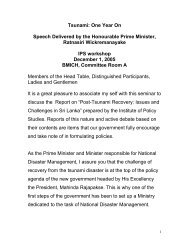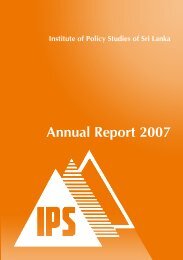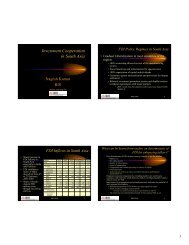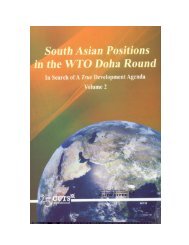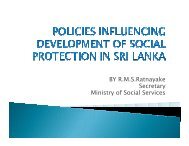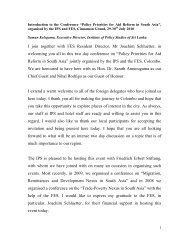Raveen Ekanayake - Institute of Policy Studies of Sri Lanka
Raveen Ekanayake - Institute of Policy Studies of Sri Lanka
Raveen Ekanayake - Institute of Policy Studies of Sri Lanka
You also want an ePaper? Increase the reach of your titles
YUMPU automatically turns print PDFs into web optimized ePapers that Google loves.
Safeguarding Consumer Interests<br />
Towards Safer Food in <strong>Sri</strong> <strong>Lanka</strong>
Trade & Food Safety: An Emerging Challenge<br />
Increased International Trade in Food Poses Both Benefits and Challenges<br />
2
Trade & Food Safety: An Emerging Challenge<br />
Horse Meat Scandal - EU<br />
Notifications from WTO members show an increasing use <strong>of</strong> non-tariff measures<br />
(SPS &TBT)
Food Safety/Quality Risks : An Overview<br />
Food Safety Risks<br />
• Microbial pathogens (i.e., illness-causing bacteria, viruses, parasites,<br />
fungi, and their toxins);<br />
• Residues from pesticides, food additives, livestock drugs, and growth<br />
hormones<br />
• Foods produced or processed with practices perceived to involve<br />
risks, such as radiation<br />
Food Quality Risks<br />
• Spoilage, contamination with filth, discoloration, <strong>of</strong>f-odours<br />
4
Food Safety Risks: <strong>Sri</strong> <strong>Lanka</strong><br />
Growing incidence/threat <strong>of</strong> food safety and quality risks<br />
• Melamine Contaminated Baby Food, Milk & Fish Feed (2008)<br />
• Ecoli contaminated canned fruits (2011)<br />
• Bird Flu infected Poultry<br />
• Adulterated brown sugar mixed with sand (2013)<br />
Documented incidence <strong>of</strong> substandard food entering the market has<br />
been sparse, anecdotal evidence suggests otherwise<br />
5
Food Safety/Quality Risks: The role <strong>of</strong> Government<br />
• Non-tariff measures (NTMs), such as SPS/TBT measures, are <strong>of</strong>ten the firstbest<br />
instruments to address food safety and trade related concerns<br />
• Sanitary and Phytosanitary Measures – Regulations Concerning food safety and<br />
animal and plant health<br />
• Technical Barriers to Trade - Regulations and standards which set out specific<br />
characteristics <strong>of</strong> a product<br />
• 94% & 23% <strong>of</strong> SPS and TBT measures respectively notified to the WTO relate<br />
to trade in agriculture<br />
6
Correcting Market Failures: SPS & TBT<br />
Information Asymmetry - producers can/ have the incentive to produce<br />
and supply substandard products<br />
MRLs, Standards & Certification could address market failure<br />
7
Correcting Market Failures: SPS & TBT<br />
Labeling allows consumers to distinguish between quality and pay<br />
according to their tastes.<br />
8
Need for Prudence in Designing/Enforcing Regulation<br />
• Compliance leads to additional costs – Increased Fixed Costs & Variable<br />
Costs<br />
• Consequences <strong>of</strong> Cost Increases<br />
• Producers cut back on export volumes<br />
• Least efficient producers stop exporting altogether<br />
• In the absence <strong>of</strong> a genuine market failure or inefficiently administered<br />
such regulations may in fact reduce consumer welfare<br />
• Reduction in the variety <strong>of</strong> goods available<br />
• Rise in prices as a consequence <strong>of</strong> the reduced supply<br />
9
Food Safety Management in <strong>Sri</strong> <strong>Lanka</strong><br />
• MRLs - Refer to the upper legal levels <strong>of</strong> a concentration for pesticide/drug<br />
residues in or on food<br />
• <strong>Sri</strong> <strong>Lanka</strong> has yet to prescribe a national list <strong>of</strong> acceptable pesticides/drugs<br />
and associated MRLs<br />
• Exporters to do not have any incentive to comply with higher standards –<br />
Heightened risk <strong>of</strong> substandard produce with unsafe level <strong>of</strong><br />
pesticide/chemical residue and/or banned substances being unwittingly<br />
consumed<br />
• Food safety risk management is conducted in a rather ad hoc and piecemeal<br />
manner<br />
• Food safety is a cross cutting issue needing a collaborative effort by all<br />
agencies concerned – need for overarching independent body/institution<br />
along the lines <strong>of</strong> the European Food Safety Authority, to better identify and<br />
coordinate actions to address perceived food safety risks<br />
10
Way Forward<br />
• Food Safety Risks are a Growing Concern Globally & Locally<br />
• A good first step would be to establish an acceptable pesticide/drug list<br />
and set MRLs<br />
• Due prudence however must be exercised to when designing such<br />
regulations to ensure unwarranted outcomes do not materialize.<br />
• Investments must be made in testing and certification facilities to<br />
ensure effective implementation <strong>of</strong> regulations<br />
• Establishment <strong>of</strong> an overarching body to better coordinate all these<br />
issues so that consumers in <strong>Sri</strong> <strong>Lanka</strong> can be ensured better food safety<br />
11
Thank You<br />
Web: www.ips.lk<br />
Blog ‘Talking Economics’: www.ipslk.blogspot.com<br />
Twitter: www.twitter.com/TalkEconomicsSL<br />
Facebook: www.facebook.com/institute<strong>of</strong>policystudies<br />
12



